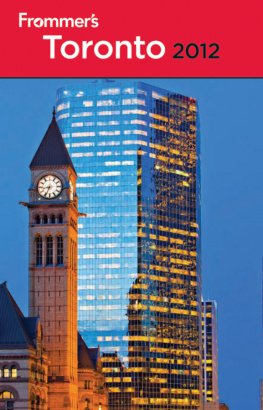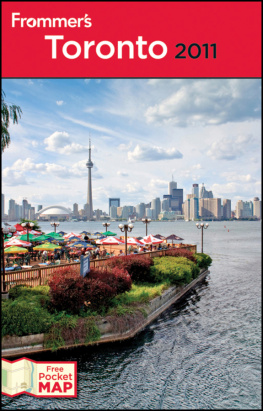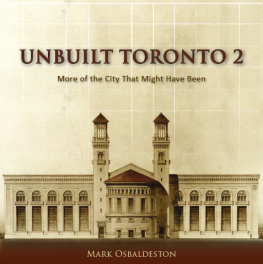MORE
TORONTO
SKETCHES
Dedicated to Yarmila,
my wife of twenty-five years,
and counting.
MORE
TORONTO
SKETCHES
The Way We Were
Mike Filey

Copyright Mike Filey, 1993
All rights reserved. No part of this publication may be reproduced, stored in a retrieval system, or transmitted in any form or by any means, electronic, mechanical, photocopying, recording, or otherwise (except brief passages for purposes of review) without the prior permission of Dundurn Press Limited. Permission to photocopy should be requested from the Canadian Reprography Collective.
Editor: Nadine Stoikoff
Designer: Andy Tong
Printed and bound in Canada by: Webcom Ltd., Toronto, Canada
The publisher wishes to acknowledge the generous assistance and ongoing support of The Canada Council, The Book Publishing Industry Development Program of the Department of Communications, The Ontario Arts Council, The Ontario Publishing Centre of the Ministry of Culture, Tourism and Recreation, and The Ontario Heritage Foundation.
Care has been taken to trace the ownership of copyright material used in the text (including the illustrations). The author and publisher welcome any information enabling them to rectify any reference or credit in subsequent editions.
J. Kirk Howard, Publisher
Canadian Cataloguing in Publication Data
Filey, Mike, 1941
More Toronto sketches
ISBN 1-55002-201-6
1. Toronto (Ont.) History. I. Title.
| FC3097.4.F54 1993 | 971.3541 | C93-095354-1 |
F1059.5.T6857F54 1993
Dundurn Press Limited
2181 Queen Street East
Suite 301
Toronto, Canada
M4E 1E5
Dundurn Distribution
73 Lime Walk
Headington, Oxford
England
OX3 7AD
Dundurn Press Limited
1823 Maryland Avenue
P.O. Box 1000
Niagara Falls, N.Y.
U.S.A. 14302-1000
Front cover photo is from a turn-of-the-century postcard.
Church Street, looking north, near Queen Street. Toronto, Ontario.
Back cover photo of Mike Filey courtesy of Toronto Sun.
Table of Contents
INTRODUCTION
Back in the fall of 1992 when the good people at Dundurn Press and I decided to assemble a selection of my Toronto Sunday Sun The Way We Were columns in a book, little did we realize just how well Toronto Sketches would be received by readers. Soon after the book arrived in local bookstores, the first printing of 3,000 was sold out and a second printing was quickly on the way.
Eventually it was decided to publish a second collection of The Way We Were columns under the title More Toronto Sketches, and this time not only would we use material from early 1993 editions of the Sunday Sun, but some of my earliest columns that ran in the mid-1970s would be featured as well. In those early days, the amount of space allotted for my column was minimal and depended in many cases on what else was to appear on the page. As a result, the text is fairly succinct and often only one photo accompanied the column. As the popularity of the column increased, so too did the space it was assigned and The Way We Were now runs a full half-page.
In More Toronto Sketches the reader will note that the date the column first appeared is included. In some cases additional material has been added if relevant changes have occurred since that original appearance.
ACKNOWLEDGMENTS
There are many people who, over the 18 or so years that I have been contributing material to the Sun, have assisted me with photos and/or stories. Many of those are Sun readers and to all of them, a sincere thanks.
Always helpful are the people in the City of Toronto Archives nestled away in the basement of new City Hall. Id particularly like to express my gratitude to Glenda, Steve, and of course, to Victor, the boss.
To the ladies in the Sun library, Joyce, Kathy, Glenna, Catherine, and Julie, thanks for all the help, and the cookies.
To Vena, Marilyn, and Kaye, people who work in the Life section, the area of the Sun where my column appears each Sunday, a special thanks. My gratitude as well to Eric and Don, the boys out in the back room, who always make my stuff look good.
And to Kirk Howard, Ian Low and their staff at Dundurn Press, Nadine Stoikoff, Andy Tong, Judith Turnbull, Jeanne MacDonald, Eileen Craig, Karen Heese, Christine Lumley, and Gordon Heyting, a hearty thanks.
AMERICAS SWEETHEART IS A TORONTONIAN
February 23, 1975
Gladys Marie Smith is said to have been born in the centre two-story building at 211 University Avenue in 1893. Eight years later the family moved to the States and little Mary started her rise to stardom. A plaque has been erected on the lawn of the Hospital for Sick Children which is the site of Mary Pickfords birthplace.
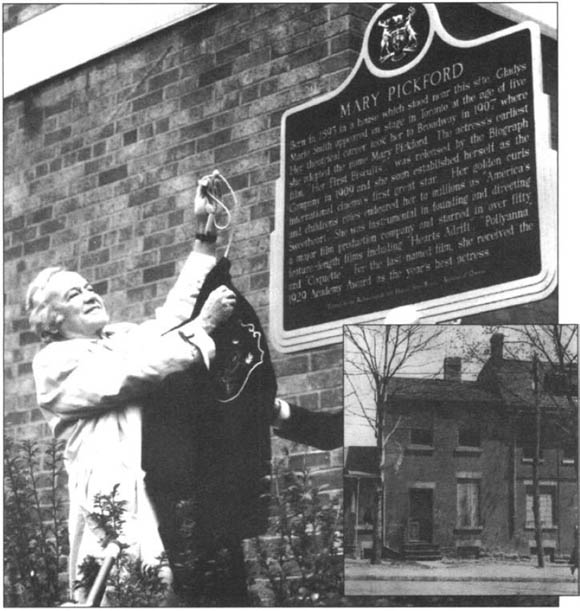
Marys husband, Buddy Rogers, unveils commemorative plaque at University Avenue and Elm Street, site of Marys birthplace (insert).
Mary Pickford died on May 29, 1979, and was buried in Forest Lawn Cemetery, Glendale, California.
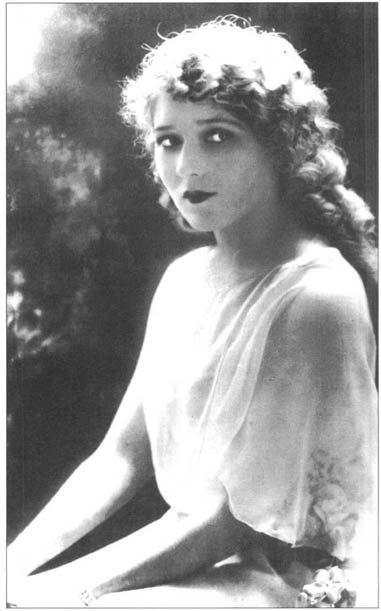
THE HOSPITAL SHOULD BE PRESERVED
December 11, 1975
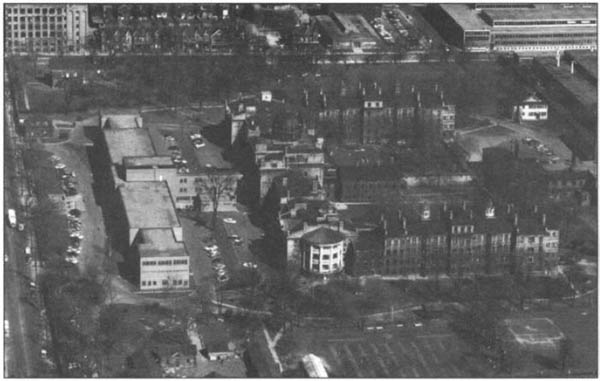
Aerial view of hospital complex, 1974. Howard building is visible in the middle of the view.
There has been much in the media recently regarding the provinces decision to demolish what is today known as the Howard Building at the Queen Street Mental Health Centre. To be specific the structure under consideration is the old building with the dome at 999 Queen Street.
In discussing the pros and cons of demolition, the most common reasons for destroying the building are the supposed bad things that took place there. It always had a frightening reputation and children were often warned that if they didnt behave they would wind up in 999. Visions of inmates staring from the windows waiting to escape also led to the publics fear of the building.
Discounting these feelings, one could argue that the structure, when it opened in 1848, was the best example of its kind anywhere on the continent. It also typified a new age of enlightenment in the treatment of mental illness.
But lets look at the building from another viewpoint. It is one of the few remaining examples of the work of one of Torontos most important citizens, John George Howard.
Born just outside London, England, on July 27, 1803, John Howard arrived in York, now Toronto, on September 14, 1832, after an ocean voyage that included a mutiny, his near drowning, and near destruction of the vessel in the St. Lawrence.
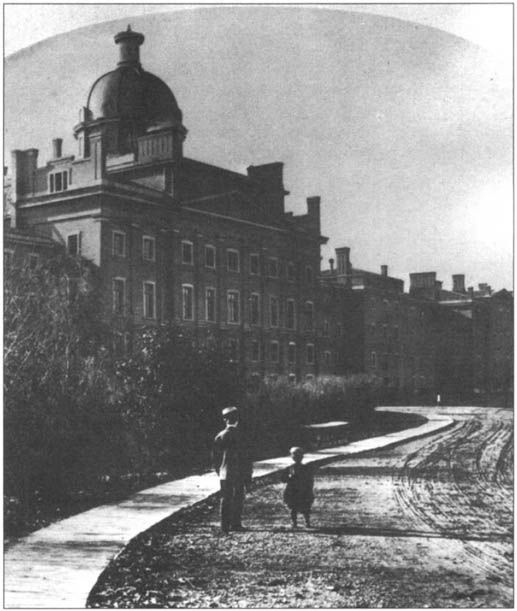
Howards first employment in his newly adopted town was as the drawing master at Upper Canada College. Soon, his talents in architecture brought requests from prominent citizens to design many houses and commercial buildings, not only in little York, but throughout Upper and Lower Canada as well.


